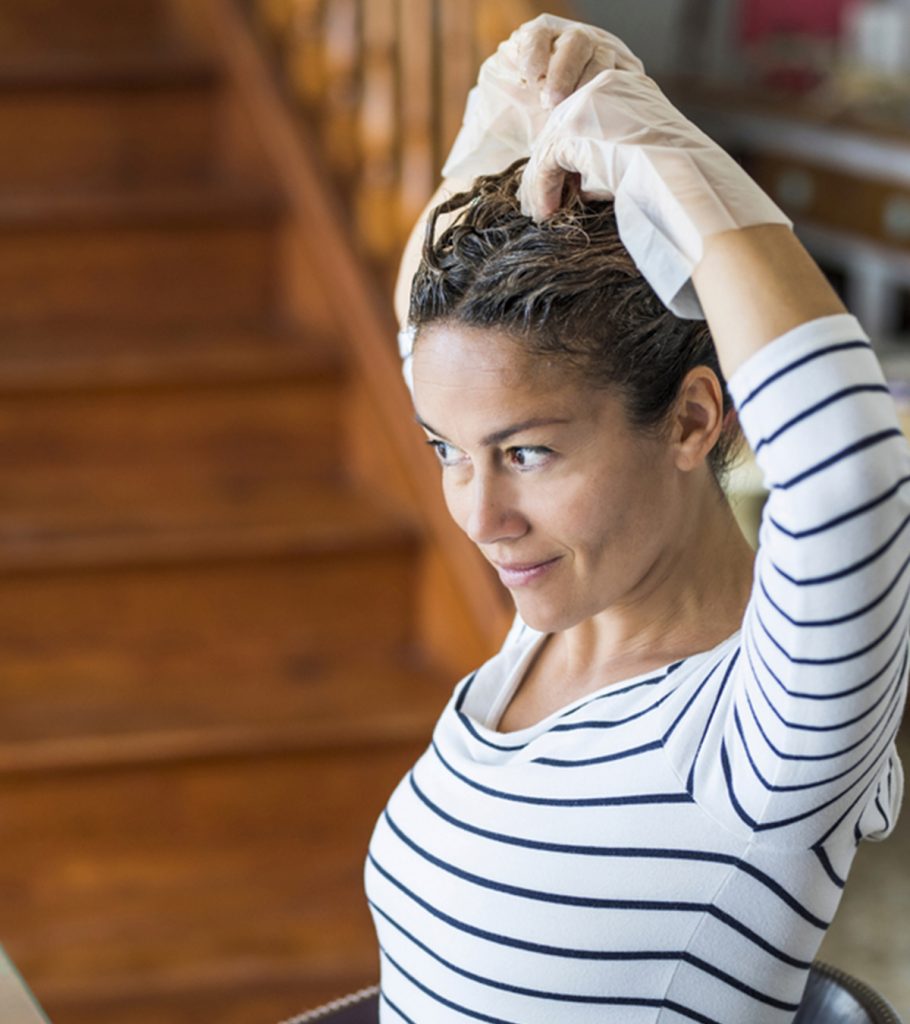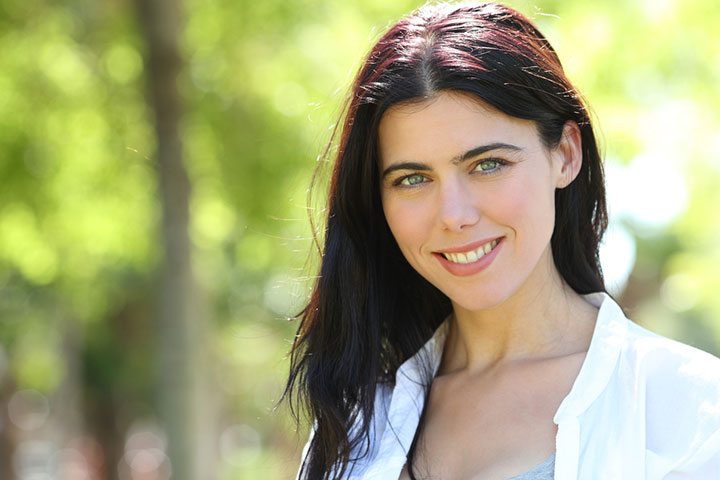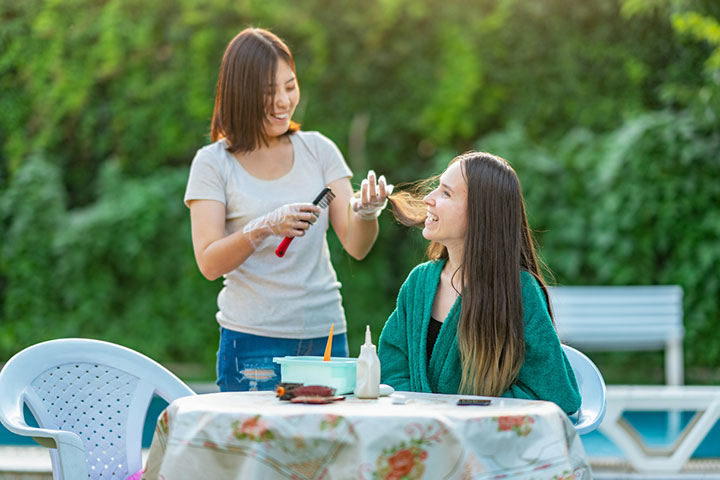The lifestyle choices of the mother may affect the infant through breast milk. For instance, lactating mothers should be cautious about using cosmetics, including hair dye while breastfeeding.
Hair dyeing can be done at home or in a salon. However, regardless of the process being done at home or in a salon, a nursing mother must be careful about choosing the hair dye product.
Read the post to know the possible concerns, safe alternatives of hair dyes, and tips on safely coloring the hair for breastfeeding mothers.
Can You Dye Your Hair During Breastfeeding?
Yes, you may dye your hair when breastfeeding. According to the NHS UK, there are no contraindications for dyeing hair when breastfeeding since very little of the dye’s compounds enter the bloodstream (1). There is no evidence that the compounds reach breast milk (2). Therefore, dyeing hair during lactation is possible without being concerned about it affecting the infant’s health.
Dr. Laila Kaikavoosi, a UK-based general practitioner and hormone specialist, says, “It is crucial to choose hair products that are free from harsh chemicals and fragrances. Opt for natural and gentle hair care products specifically designed for breastfeeding mothers. These products generally contain fewer chemicals and are less likely to trigger sensitivities. By making this simple switch, you could maintain healthy hair while safeguarding your baby’s well-being.”
Precautions For Dyeing Hair During Breastfeeding
Although dyeing hair during breastfeeding does not affect the baby, it is good to observe the following precautions.
1. Choose temporary hair dyes
Temporary hair dyes stay on the hair’s surface and do not enter the hair shaft (3). They could be safer when compared to semi-permanent and permanent hair dyes, which may enter the hair shaft and reach the bloodstream. Therefore you must maintain caution while choosing the type of hair dye to use during breastfeeding.
2. Use softer colors
Darker colors may contain more coloring agents and other color-fixing compounds that may be harmful. You may pick lighter or softer hair dye tones that may contain less concentration of compounds that enter the bloodstream.
3. Check for potentially harmful ingredients
Check the contents of the hair dye irrespective of dyeing your hair at home or the salon. Permanent hair dyes may more likely contain potentially harmful compounds, such as phenols, aromatic aminesiXOrganic compounds that are by products of dyes, rubber and drug-manufacturing industries with potential carcinogenic activity, and hydrogen peroxideiXA chemical compound found as a colorless liquid and used as an oxidizer and bleaching agent (3).
Below are some of the potentially harmful compounds that may be found in different types of dyes (4). These compounds may adversely affect you and your baby’s health during motherhood.
- Aromatic amino compounds
- NaphthylamineiXA type of aromatic amine used in dye and rubber industries and to control weeds
- PhenylenediaminesiXAn organic compound used as permanent dyes and in a dye the development of photographs
- TolueneiXAn aromatic hydrocarbon used in paint thinners, permanent markers, and nail polish
- Ammonia
- Silver
- Mercury
- Arsenic
- Lead
- Bismuth
- PyrogalloliXAn organic compound, used in the development of photographs, dyes, and in the preparation of other chemicals
- Alcohol and its compounds
4. Do a strand test
Apply a small amount of the hair dye on a strand of hair and a small patch of the scalp to check its suitability. Hair dye allergy is not uncommon due to sensitivity toward the compounds present in the dye. The risk may be higher if you choose permanent hair dyes, which may contain paraphenylenediamine (PPD), which may cause allergies in a few people (5). Skin rash, irritation, and itching are common symptoms of an allergic reaction.
5. Dye hair when away from the baby
Dye your hair in a well-ventilated area away from the baby. Even the safest hair dyes may contain volatile compounds, which may irritate the baby’s airways. Make sure you shower and rinse away the applied dye before handling the baby again.
Wash your hair before breastfeeding your baby as one of the cautionary measures. Aroma of hair dye can induce a runny nose and coughing in your baby. Your baby’s skin is highly sensitive, any contact with hair dye can induce severe allergy in your baby.
Possible Side Effects Of Hair Dye During Breastfeeding
You may experience the following general side effects of hair dye that may not affect breastfeeding and your breastfeeding baby (6).
- Local skin redness
- Itchiness
- Split ends
- Loss of hair’s luster
- Scaling of the scalp
- Hair dryness
- Loss of hair
- Premature hair graying
- Slow hair growth
The side effects may vary based on the type and color of hair dye used. Side effects may more commonly occur with semi-permanent and permanent hair dyes than temporary hair dyes, which may often wash away in a couple of showers.
Possible Alternatives To Hair Dyes
Natural vegetable colors could be safe alternatives to commercial hair dyes. Homemade vegetable dyes will not last very long on the hair. However, homemade vegetable dyes are unlikely to be harmful even if they enter the bloodstream through the hair shaft.
Below are some ideas for homemade vegetable-based dyes that you may pick over commercial, chemical-based dyes.
- Beetroot juice for violet: Blend beetroot pieces and strain the juice. Mix the juice with coconut oil, add a dash of lime juice, and apply it to your hair. You may wear a plastic shower cap on top of it and leave it for an hour. Rinse away with shampoo as usual.
- Coffee extracts for deep brown: Brew crushed roasted coffee beans (not instant coffee) in hot water. Strain the liquid and let it cool. You may add a tablespoon of green tea to the mix to nourish the hair and possibly improve the color’s potency. Mix the coffee mixture with a leave-in type of hair conditioner. Apply it to your hair after a shower, leave it for an hour, and wash it off.
- Carrot juice for orange: Blend carrot pieces, strain the juice, and mix it with a carrier oil, such as coconut oil. Add a bit of lime juice and apply it to your hair. Cover with a plastic shower cap and leave it for an hour. Rinse as usual.
- Black plum paste for purple: Cut out the pulp and skin of black plum (jamun). Blend to make a thick paste. Apply to dry hair, cover with a plastic shower cap, and leave it for an hour. Shower and rinse away thoroughly.
- Sage for light brown: Steep sage dry sage leaves in hot water to make sage tea. Strain the water and let it cool. Rinse your hair with cooled sage tea for a few minutes after a shower. Comb the hair and let them air dry.
- Chamomile tea for yellow: Steep dry chamomile flowers in hot water to make chamomile tea. Brew the flowers for longer to attain a deeper hue. Rinse your hair multiple times with cooled chamomile tea. Pat dry your hair and comb.
- Henna for red: Purchase natural henna powder with no added dyes or chemicals. Mix the powder in water as per instructions on the packet and apply it. Cover the hair with a plastic shower cap. You may leave it for a couple of hours to attain a deeper shade of red. Rinse and wash away later.
Dr. Alan Lindemann, obstetrician and maternal mortality expert from North Dakota, says, “I suggest using only semi-permanent vegetable dyes like henna. I would also recommend highlighting your hair, ensuring it only touches your hair, not the scalp. While you may still smell the highlighting fluid, try to keep it away from your scalp as much as possible.”
You may use a different quantity of vegetables or steep coffee or tea for longer to attain different intensities of hair color. You may also use other bases, such as post-shower hair gels, if you wish to leave the color on your hair for longer.
There are no contraindications to using hair dye while breastfeeding. Ensure your hair dye does not include harmful chemicals such as aromatic amino compounds, silver, or mercury. Although small amounts of dying compounds may enter the breast stream, they may not cause any effects on the mother and the breastfed baby. You may try temporary dyes rather than permanent dyes since they may not enter the hair shafts. You may also try natural hair dyes such as vegetable dyes from beetroot extract, coffee extract, or henna.
Key Pointers
- NHS UK shows no contraindications to coloring your hair while breastfeeding.
- Remember to choose temporary hair dyes with softer colors and examine their contents before dying.
- Always wash your hair before nursing and dye it in a well-ventilated environment away from the infant.
- Natural vegetable colors, such as coffee extract and beetroot juice, can be used as safe alternatives to commercial hair dyes.
Have you been wondering about the safety of hair coloring while pregnant or breastfeeding? Learn the risks and benefits of this beauty routine from this expert video.















